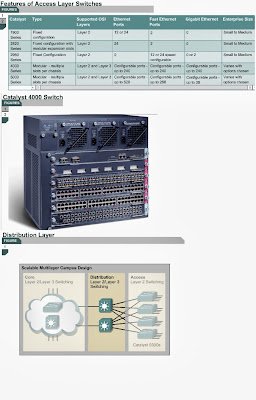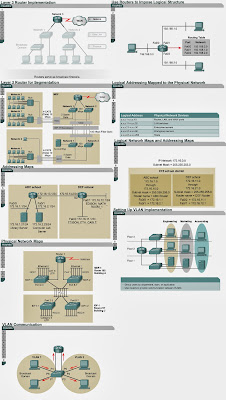Summary
Before moving on to Module 6, the students must be proficient in explaining the concepts of LAN switches and LAN design.
Online assessment options include the end-of-module online quiz in the curriculum and the online Module 5 exam. From memory students should be able to complete the Matching LAN Design and Goals activity and the Point and Click Core Layer activity.
An understanding of the following key points should have been achieved:
LAN design depends on the requirements of individual organizations but typically focuses on functionality, scalability, manageability, and adaptability. For a LAN to be effective, it should be designed and implemented based on a planned series of systematic steps. The steps require data and requirements to be gathered and analyzed, Layers 1,2, and 3 implemented, and everything to be documented. The following are important LAN design documentation:
The logical diagram of the LAN includes the locations and identification of the MDF and IDF wiring closets, the type and quantity of cables used to interconnect the IDFs with the MDF, and the number of spare cables available to increase the bandwidth between the wiring closets.
Layer 2 devices provide flow control, error detection, error correction, and reduce congestion in the network. Bridges and LAN switches are the two most common Layer 2 network devices. Microsegmentation of the network reduces the size of collision domains and reduces collisions.
Routers are Layer 3 devices that can be used to create unique LAN segments. They allow communication between segments based on Layer 3 addresses, such as IP addresses. Implementation of Layer 3 devices allows for segmentation of the LAN into unique physical and logical networks. Routers also allow for connectivity to WANs such as the Internet.
VLAN implementation combines Layer 2 switching and Layer 3 routing technologies to limit both collision domains and broadcast domains. VLANs can also be used to provide security by creating the VLAN groups according to function and by using routers to communicate between VLANs.
The hierarchical design model includes three layers. The access layer provides users in workgroups, access to the network. The distribution layer provides policy-based connectivity. The core layer provides optimal transport between sites. The core layer is often referred to as the backbone.
Access layer switches operate at Layer 2 of the OSI model and provide services such as VLAN membership. The main purpose of an access layer switch is to allow end users into the network. An access layer switch should provide this functionality with low cost and high port density.
The distribution layer switch is a point at which a broadcast domain is delineated. The distribution layer combines VLAN traffic and is a focal point for policy decisions about traffic flow. For these reasons, distribution layer switches operate at both Layer 2 and Layer 3 of the OSI model. Switches in this layer are referred to as multilayer switches.
The core layer is a high-speed switching backbone. This layer of the network design should not perform any packet manipulation. Packet manipulation, such as access list filtering, would slow down the switching of packets. A core infrastructure with redundant alternate paths give stability to the network in the event of a single device failure.
Before moving on to Module 6, the students must be proficient in explaining the concepts of LAN switches and LAN design.
Online assessment options include the end-of-module online quiz in the curriculum and the online Module 5 exam. From memory students should be able to complete the Matching LAN Design and Goals activity and the Point and Click Core Layer activity.
An understanding of the following key points should have been achieved:
- The four major
goals of LAN design
- Key
considerations in LAN design
- The steps in
systematic LAN design
- Design issues
associated with Layers 1, 2, and 3
- The three-layer
design model
- The functions of
each of layer of the three-layer model
- Cisco access
layer switches and their features
- Cisco
distribution layer switches and their features
- Cisco core layer switches and their features
LAN design depends on the requirements of individual organizations but typically focuses on functionality, scalability, manageability, and adaptability. For a LAN to be effective, it should be designed and implemented based on a planned series of systematic steps. The steps require data and requirements to be gathered and analyzed, Layers 1,2, and 3 implemented, and everything to be documented. The following are important LAN design documentation:
- OSI layer
topology map
- LAN logical map
- LAN physical map
- Cut sheets
- VLAN logical map
- Layer 3 logical
map
- Address maps
The logical diagram of the LAN includes the locations and identification of the MDF and IDF wiring closets, the type and quantity of cables used to interconnect the IDFs with the MDF, and the number of spare cables available to increase the bandwidth between the wiring closets.
Layer 2 devices provide flow control, error detection, error correction, and reduce congestion in the network. Bridges and LAN switches are the two most common Layer 2 network devices. Microsegmentation of the network reduces the size of collision domains and reduces collisions.
Routers are Layer 3 devices that can be used to create unique LAN segments. They allow communication between segments based on Layer 3 addresses, such as IP addresses. Implementation of Layer 3 devices allows for segmentation of the LAN into unique physical and logical networks. Routers also allow for connectivity to WANs such as the Internet.
VLAN implementation combines Layer 2 switching and Layer 3 routing technologies to limit both collision domains and broadcast domains. VLANs can also be used to provide security by creating the VLAN groups according to function and by using routers to communicate between VLANs.
The hierarchical design model includes three layers. The access layer provides users in workgroups, access to the network. The distribution layer provides policy-based connectivity. The core layer provides optimal transport between sites. The core layer is often referred to as the backbone.
Access layer switches operate at Layer 2 of the OSI model and provide services such as VLAN membership. The main purpose of an access layer switch is to allow end users into the network. An access layer switch should provide this functionality with low cost and high port density.
The distribution layer switch is a point at which a broadcast domain is delineated. The distribution layer combines VLAN traffic and is a focal point for policy decisions about traffic flow. For these reasons, distribution layer switches operate at both Layer 2 and Layer 3 of the OSI model. Switches in this layer are referred to as multilayer switches.
The core layer is a high-speed switching backbone. This layer of the network design should not perform any packet manipulation. Packet manipulation, such as access list filtering, would slow down the switching of packets. A core infrastructure with redundant alternate paths give stability to the network in the event of a single device failure.




